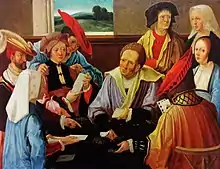Juckerspiel
Juckerspiel, also known as Jucker or Juckern, is a card game that was formerly popular in the Alsace region. It is purported to be the ancestor of Euchre and to have given its name to the playing card known as the Joker. No definitive rules are known.
| Origin | Alsace |
|---|---|
| Type | Plain-trick game |
| Family | Euchre group |
| Card rank (highest first) | J > A, otherwise unknown |
| Related games | |
| possibly Euchre, Juckerspiel, Lanterloo, Reunion | |
History
The earliest known record of the game of Jucker occurs in Spindler's 1848 book, Forget-me-not (Vergißmeinnicht), a pocket book "dedicated to love, friendship and family life"[1] and occasional references surface during the second half of the nineteenth century.[2][3][4]
Little is known of its rules, but in 1899, Martin and Lienhart describe Jucker as a "card game in which the Bauer [i.e. Jack] is worth more than the Ace" and a Marsch was to take all five tricks in Juckerspiel.[5] In 1908, Rausch confirms that, in Alsace, in the "widespread Juckerspiel", the phrase e Marsch mache means to take all the tricks and that the Bauer is the highest card.[6]
Later literary references to the game appear in the Rhineland and South Hessian region.[7][8]
Recently, David Parlett has stated that, "on linguistic grounds alone there can be no doubt as to [Euchre's] origin in the Alsatian game of Juckerspiel as brought to America by German immigrants." Not only are Jucker and Euchre phonetically alike, but the terms Bauer and Marsch have been imported into Euchre as 'Bower' and 'march'.[9] However, there are numerous other German games that use the same terms and references to Jucker do not pre-date those to Euchre, so the link remains tenuous.
Related games
The game of Reunion, a 19th-century Rhineland game, shares the feature of having two Jacks as the top trumps, but is a three-hand game played with 10-card hands and a 32-card Skat pack. Recently, members of the International Playing Card Society identified two games, still being played today in the region north of Alsace in Germany, that appear to be descendants of Juckerspiel: Bauer and Hunsrücker Bauern.[10]
Bauer
Bauer is a four-handed, plain-trick game played in the Saarland. It employs a 32-card, French-suited Skat pack and there are 2 Jacks (Bauer) as top trumps: the trump Jack or Dicke ("fat one") and the Jack of the same suit colour or Linke ("left one"). Players form two teams of two and are dealt 8 cards each. Suit must be followed, but players may play any card if unable to follow. Teams start with eight points and aim to be first to zero, one game point being deducted to the winners of a deal if they declared trumps. If the declarers lose, they add a point and their opponents deduct one.[10][11]
Hunsrücker Bauern
The variant of Bauer, or Bauern, played in the Hunsrück, uses 32 French-suited cards and is a six-handed, two-team game in which there are, again, two Jacks as top trumps. If the cut card is a Jack, it determines the trump suit unless superseded later. Players are dealt five cards each from a Skat pack and, if trumps have not already been decided, the top card of the skat is turned for trumps. If it is a Jack, it determines trumps even if the cut card was a Jack. If it is a Jack, the bottom card of the skat is turned and, if it is the same suit, dealer may exchange with it. If not, players are asked in turn if they will play with the turnup suit. If any player says yes, the dealer may exchange with it. If no-one wants to play with the turnup suit, it is turned over again and players are asked if they will play with another suit. If all pass, the cards are redealt. This process is similar to that used in Euchre. Teams start with five lines marked on a slate (Striche) and play for the best of five tricks. If the declarers win, they erase a line; if they lose, they add a line and the winners erase a line.[10][12]
References
- Spindler 1848, p. 170.
- _ 1856, p. 72.
- Erckmann-Chatrian 1864, p. 132.
- Rottmann 1874, p. 203.
- Martin and Lienhart 1899, pp. 406b and 713b.
- Rausch 1908.
- Müller 1928.
- Maurer 1965, p. 990.
- EUCHRE and related five-trick games at www.parlettgames.uk. Retrieved 14 Jun 2019
- Bauer -- Euchre in its area of origin at i-p-c-s.org. Retrieved 4 Jul 2019.
- Bauer (Kartenspiel) at www.spielwiki.de. Retrieved 4 Jul 2019.
- Re: Bauern Hunsrücker Kartenspiel at www.wer-weiss-was.de. Retrieved 4 Jul 2019.
Literature
- Erckmann-Chatrian (1864). L’Ami Fritz. 6th edn (1877). Librairie Hachette, Paris.
- Martin, Ernst and Hans Lienhart (1899). Wörterbuch der elsässischen Mundarten, Vol. 1 (A E I O U F V G H J K L M N), Trübner, Strassburg.
- Maurer et al. (1965-2010). Südhessisches Wörterbuch.
- Müller, Josef (1928). Rheinisches Wörterbuch, Vol. 3. Fritz Klopp, Bonn.
- Parlett, David (1990). A History of Card Games, OUP, Oxford. ISBN 0-19-282905-X
- Rausch, Heinrich Adam (1908). "Das Spielverzeichnis" in the 25th chapter of Fischart's "Geschichtklitterung" (Gargantua). Heitz.
- Rottmann, P. J. (1874). Gedichte in Hunsrücker Mundart, R . Voigtländer, Kreuznach.
- Spindler, Carl (1848). Vergißmeinnicht: Taschenbuch der Liebe, der Freundschaft und dem Familienleben gewidmet. Franckh, Stuttgart.
